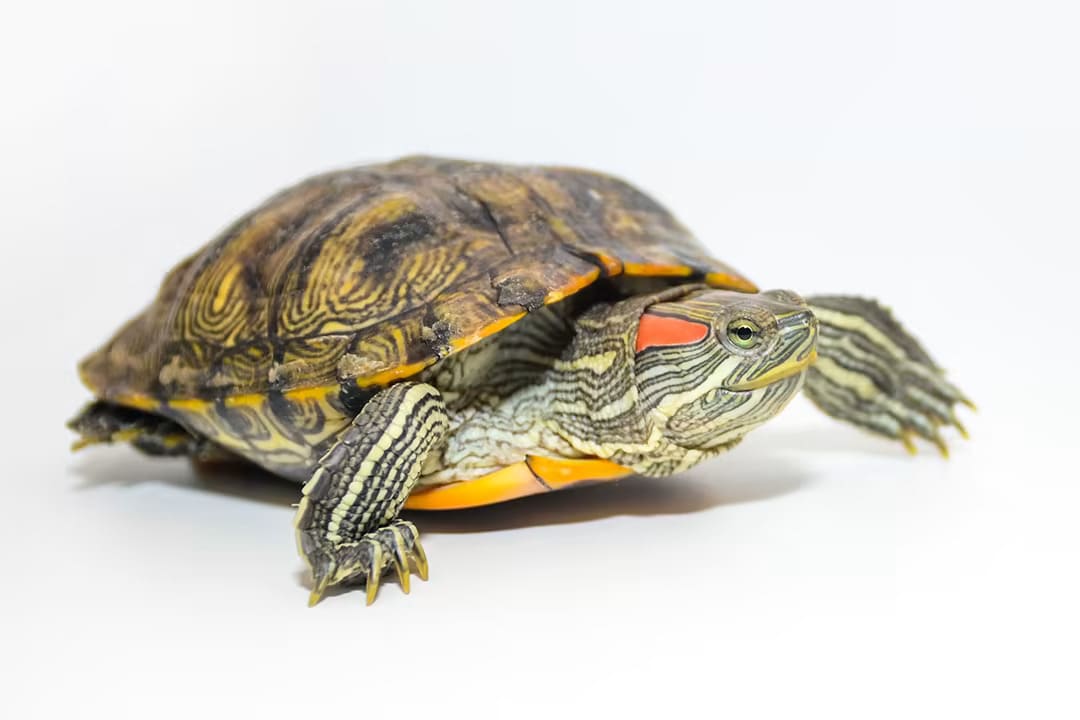Let’s find out Do red-eared turtles eat bananas or not? Red-eared slider turtles are omnivores and eat a varied diet.
Some key points to understand about their dietary needs:
As juveniles they eat more protein to support growth. They eat foods like small fish, tadpoles, worms, and insects. Pellets made for juvenile turtles also provide protein.
As adults, their diet shifts more towards vegetation. They eat aquatic plants like duckweed and water lettuce as well as some land plants that hang over the water.
Good vegetables to feed red-eared sliders include dark leafy greens like kale and romaine lettuce as well as bits of carrot and squash. Too much fruit should be avoided.
Let’s find out the answer to the question “Can Red Eared Slider Turtles Eat Bananas?”.
Can Red Eared Slider Turtles Eat Bananas?

Yes, red-eared slider turtles can eat bananas, but only in moderation as an occasional treat.
Here are some key points around feeding bananas to red-eared sliders:
Bananas are high in phosphorus and sugar compared to other fruits and vegetables. Too much can lead to an imbalance with the turtle’s calcium levels.
Bananas should be fed sparingly, around once a week to juveniles and even less frequently for adult red-eared sliders.
The banana slice given should be small, around the size that could fit inside the turtle’s head. Do not give whole pieces of banana.
Bananas should be fresh. Avoid feeding overripe or fermented bananas as this can cause digestive issues.
Bananas should complement, not replace other staple foods in a red-eared slider’s diet like leafy greens, aquatic plants, commercial turtle pellets, fish, insects etc. A varied diet is important.
Always wash hands after touching or preparing bananas or any human food fed to turtles to prevent passing bacteria or other contaminants to the turtle.
We can say that bananas as an occasional, fresh, small-portioned treat are fine for red-eared sliders, but should not become a diet staple. Moderation with banana feeding is key.
What Fruits and Vegetables Can Red Eared Slider Turtles Eat

Red-eared slider turtles can enjoy a diverse mix of fresh fruits and vegetables as part of their omnivorous diet.
Leafy greens should form the foundation of any red-eared slider’s veggie intake. These aquatic turtles thrive on daily meals of kale, collard or turnip greens which provide plentiful calcium, vitamins A, C and K, along with antioxidants.
Red-eared sliders also benefit from the cartenoids in carrots, sweet potatoes and squashes like zucchini or butternut.
These orange and yellow pigmented vegetables can be shredded or finely chopped and offered 2-3 times a week. Some other nutritious staples are broccoli, peas and green beans which can be rotated through the weekly menu as well.
Fruit can add beneficial variety and nutrients too. Red-eared slider favorites with naturally high moisture content are cantaloupe, berries and apples. Melons like honeydew and cantaloupe give excellent potassium levels when fed in small cubes.
Raspberries, blueberries and sliced strawberries supply antioxidants without much acidic citric juice, making them the best berries for sliders. Apples, mangos and bananas can be incorporated sparingly as well since they have higher sugar content.
All fruits should be ripe and fresh before chopping up for the turtle’s consumption. As a general rule, vegetables should make up the bigger portion of any red-eared slider’s plant-based intake.
Focusing on dark leafy greens at one meal and adding in small amounts of mixed fruits and veggies at another daily feeding ensures sliders get the carbs, fiber, nutrients and hydration from plants necessary for balanced health.
What Human Food Can Red Eared Slider Turtles Eat
Red-eared slider turtles can safely eat some human foods, though these should complement and not fully replace a complete commercial turtle diet.
When feeding “people” foods to a red-eared slider, it’s important to offer variety and mindfulness around healthy options that meet the needs of an omnivorous turtle.
Some nutritious human protein options to consider include plain cooked chicken, lean beef or egg scrambled with no added fat or salt.
Unseasoned deli meats like turkey and ham, finely shredded or chopped can also add beneficial protein.
Chopped hard boiled eggs, plain yogurt and bits of shrimp or surimi crab can be fed in moderation too. Just like us, slider turtles enjoy small amounts of healthy nuts like pecans which give fats, fiber and nutrients. All human proteins fed should have no added preservatives or sodium.
Fresh produce can spur variety. Leafy greens like kale, collard or turnip greens offer calcium and carotenoids. Sweet potatoes, zucchini and fresh berries like raspberries add healthy plant pigments.
Some fruits high in phosphorus like melon and apples should be fed judiciously. No citrus fruits should be fed. All produce should be raw and finely chopped or shredded before serving.
Some healthy whole grains can be offered too – a few oat rings, bits of brown rice or quinoa add beneficial fiber and carbohydrates. Just like protein options, only plain varieties should be selected.
A red-eared slider’s diet should still consist primarily of a quality commercial pellet plus natural forage, with human foods included to add diversity a few times a week. This balance prevents malnutrition.

Leave a Reply